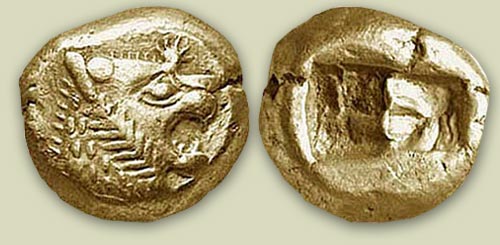|
The world's first coins
by David Albanese Throughout history gold has motivated empires; it has been the rise to power and downfall for kings, emperors, and dictators as long as man has walked the earth. It has a magical lure within its surfaces that captivates humans and draws them into another world, a world of power and beauty. The first coins ever to be recorded on earth were gold and silver denominational coinage minted by the Lydian's around 600 BC. The Lydian coin pictured below, called a third stater (or trite) is perhaps the largest denomination of its type and without question the most common. This coin was minted around 600 BC in Lydia, Asia Minor (modern-day Turkey), a country in close proximity to both the civilizations of Mesopotamia, from which ideas about money and much else originated, and the Greek colonies in Asia Minor, through which ideas about coinage and much else spread. The techniques were quickly copied and further refined by the Greek, Persian, Macedonian, and later the Roman empires. Unlike Chinese coins which depended on base metals, these new coins were made from precious metals such as silver, bronze, and gold, which had more inherent value. 
The world's first coin: The Lydian Lion The above coin is smaller in diameter than a U.S. half dime but is thick as a pebble and weighs almost as much as a U.S. quarter. It's made of electrum, an alloy of gold and silver called "white gold" in ancient times (50-60 percent gold with these coins). At the time of its minting, it may have been worth about a month's subsistence, a sizeable chunk of change. The above coin is a more refined and more attractively rendered variety of the same type minted a decade earlier. One of the many fascinating aspects of this coin is the mysterious sunburst above the lion's eye. To think of the skill it took to hand engrave the design on those little planchets is mind blowing. The Lydian's invented a way to verify if gold was pure or not, they used a black stone that was like jasper and later became known as the touchstone. The goldsmiths would rub the gold object against a set of 24 needles containing varying amounts of the 3 metals: gold, silver, and copper. The 24th needle of course was pure gold, thus creating the system to show that 24 carats is pure gold, (carat is a word derived from the Greek word Keration.) In modern times coins have become their own world, a world of collecting, investing and obsession. With the instability of the stock market which has proven so throughout history, people are finding that rare certified coins are the place to diversify into, a place that is stable and proven so due to the consistency of high prices being paid and the amount of people that actually purchase coins: That fact alone shows the demand for consumers is solid, and the amount of people buying coins outnumber the amount of rare coins that truly exist. People who collect original art paintings, early Americana antiques, and historic objects all around are finding rare American gold certified coins are as beautiful, scarce and valuable as all mentioned above. David M. Albanese, CEO, Albanese Rare Coins, Inc. David Albanese is a Nostomania coins advisor. Albanese Rare Coins can be reached at their outstanding web site. Visit our Coin News Archive. |